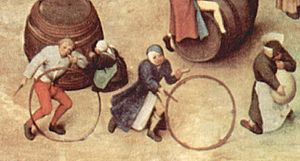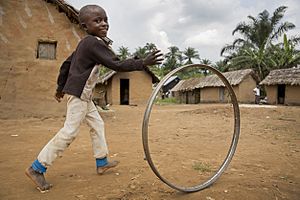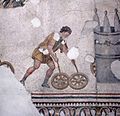Hoop rolling facts for kids
Hoop rolling is a fun sport and game where you roll a large hoop along the ground. You usually use a stick or a special hook to push it. The main goal is to keep the hoop rolling upright for a long time. You can also try different tricks with it!
People have played hoop rolling for a very long time. It has been around in Africa, Asia, and Europe since ancient times. It was often played as a game where you aimed at a target. In Asia, the first records are from Ancient China. In Europe, it dates back to Ancient Greece.
In Western countries, hoops were usually made of wood or metal. Wooden hoops were pushed with a stick about one foot long. You would hit the center of the hoop with the stick to keep it going. Metal hoops were often guided with a metal hook instead of being hit.
Contents
Hoop Rolling Today
In the early 1800s, travelers saw children playing with hoops all over Europe and other places.
This game was also popular with children in African villages. It was played in China as early as 1000 BC. Christian missionaries saw children playing it there in the 1800s. Kids in Japan also played hoop rolling during the late Edo period.
In English, this sport has a few names. People call it "hoop and stick" or "bowling hoops." In Scotland, it's known as "gird and cleek." Here, the "gird" is the hoop, and the "cleek" is the stick.
Around the late 1800s in the West, boys up to about twelve years old played this game. Sometimes, hoops had small tin squares nailed inside. These would jingle as the hoop rolled, making a fun sound. Some people liked wooden hoops better than iron ones. Iron hoops could break windows or hurt people's legs.
Different Hoop Games
Besides just rolling hoops forward and keeping them upright, there are other games too. These include hoop races and games that test your skill.
One skill game is "toll." In this game, you have to roll your hoop between two stones that are only a few inches apart. You must not touch either stone!
Another game is "turnpike." One player rolls their hoop between pairs of objects, like bricks. At first, the opening is about a foot wide. Other players guard each "gate." After rolling through all the gates, the openings are made smaller. The player rolls the hoop through the course again. This keeps going until the hoop hits the side of a gate. Then, the player and the gate keeper switch places.
You can also play conflict games like "hoop battle" or "tournament." In these games, teams try to knock down their opponents' hoops. Only hoops that fall because another hoop hit them count. In some parts of England, a similar game was called "encounters." Two boys would roll their hoops at each other. The one whose hoop stayed standing was the winner.
The "hoop hunt" is another game. One or more hoops are rolled down a hill. The goal is for the hoop to roll as far as possible. Then, players have to find where the hoop ended up.
Hoop Rolling in the British Empire
Children in England have played hoop rolling since the 1400s. By the late 1700s, boys rolling hoops in London streets became a problem. People complained that iron hoops caused injuries to pedestrians' legs. The London police tried to stop this. They took away iron hoops from boys and girls rolling them in the streets and parks. But this didn't stop the game, and complaints continued.
Some writers made fun of the complainers. They said these people were taking away a healthy and harmless game from kids. This game had been played for hundreds of years without causing big problems. One writer joked about making laws for everything, even "the laughter of the hoop-trundling boy." In the 1860s, a scientist named Charles Babbage also complained. He said boys were rolling iron hoops under horses' legs, causing riders to fall and horses to break legs.

The complaints about hoops even reached places far away, like the Colony of Tasmania. There, people blamed boys rolling hoops for scaring horses and tearing ladies' dresses. The local newspaper asked for the game to be banned from city areas.
Not just schoolboys, but even university students at Cambridge enjoyed rolling hoops after their classes. But this stopped before 1816. A rule was made that said Masters of Arts could not roll hoops or play marbles.
By the early 1800s, hoop rolling was part of physical education for girls. It was played along with jumping rope and dumbbells. Hundreds of girls from four to fourteen years old could be seen rolling their hoops in London parks.
In the mid-1800s, bent ash wood was popular for making wooden hoops. In early 1900s England, girls used wooden hoops with wooden sticks. Boys often had metal hoops with key-shaped metal sticks. Some stores sold hoops with spokes and bells, but boys often didn't like these as much.
Another name for hoop rolling is Gird ‘N Cleek. The World Gird ‘N Cleek championships are held every year in New Galloway, Scotland. Past winners include Andrew Firth (1983), Alexander McKenna (2009, 2018), and Arthur Harfield (2019).
Hoop Rolling in America
Many Native American peoples played an old target-shooting version of hoop rolling. It is now known as Chunkey. This game had many different forms. But usually, it involved rolling a disc or hoop very fast on a prepared ground. Then, players would throw spear-like objects at it. When adults played, the game was often linked to gambling. Very valuable prizes, like horses, were sometimes won or lost. Tribes like the Arapaho, the Omaha, and the Pawnee played this game.
Since hoop and stick involves throwing spears, people think it was played before bows and arrows were used, which was around 500 AD. In California in the 1700s, it was a common game called "takersia." Canadian Inuit players would divide into two groups. One group rolled a large and a small hoop. The other group tried to throw spears through the hoops. The Cheyenne tribe even named two months after the game: January was "Hoop-and-stick game moon," and February was "Big hoop-and-stick game moon." Among the Blackfeet, children would throw a feathered stick through a rolling hoop. Salish and Pend d'Oreilles youth played hoop and arrow games. They did this in early spring to practice hunting small animals for their village.
For European settlers, hoop rolling was a seasonal sport. It was most popular in the winter. Besides rolling hoops, children also tossed them back and forth, catching them on their sticks. In the 1830s, hoop rolling was seen as a typical activity for young people. It was even adopted by a religious group in Kentucky. Its members copied children's activities to try and get into heaven. Hoop rolling was also seen as a good way for American girls in the mid-1800s to be more active. The game was popular with both girls and boys. In an 1898 survey of 1000 boys and 1000 girls in Massachusetts, both groups said hoop and stick was their favorite toy. In Ohio, the wood from the American elm tree was especially good for making hoop-poles.
At Bryn Mawr College, Wellesley College, and Wheaton College, the Hoop Rolling Contest is an annual spring tradition. It started in 1895 and is only for graduating students on their May Day celebration.
Images for kids
See also
 In Spanish: Aro (juguete) para niños
In Spanish: Aro (juguete) para niños






